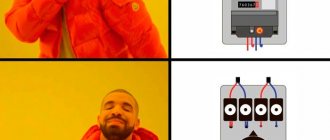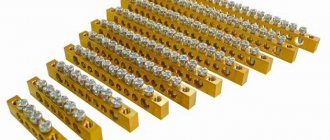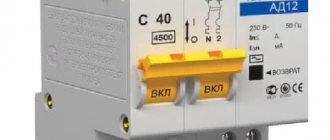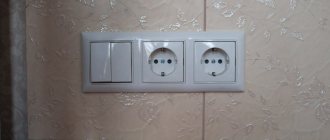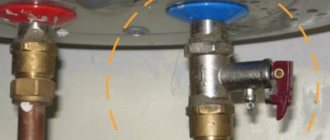In any case, it is impossible to do without protective elements of the electrical network in the apartment and in the country. These devices not only prevent serious consequences in the event of a short circuit and protect against exceeding permissible loads in the network, but also prevent current leakage. In most cases, circuit breakers, or “circuit breakers,” are used to protect devices from the consequences of a short circuit, while residual current devices (RCDs) are used to protect against possible leaks.
At the same time, both are well solved by combined devices, which have a mathematical name - differential circuit breakers, or “differential circuit breakers”. These are very convenient devices that combine two functions in one housing: an RCD and a circuit breaker.
Difavtomat or RCD - which is better?
And first of all, it is necessary to clarify: a differential circuit breaker is no better or worse than an RCD, and vice versa. The choice should be based on the specific tasks and conditions in which they will be used.
A clear example in this part will be that if a differential circuit breaker turns off all or part of the wiring in the event of an overload or short circuit, then the RCD will do the same, but in the event of a current leak. To put it simply, metering usually means insulation damage when current “leaks” into the ground, which is important when conductive elements hit the ground or anywhere else. This does not apply to the normal operation of the device and also poses a danger to people and their property. Ideally, it is recommended to install the devices together, as one complements the other.
As a result, the choice between the two systems, if you approach it too categorically, does not make any sense at all, since it is often impossible to predict the cause of the problem. However, if there is absolute confidence that a network overload is more likely to occur than a current leak, and vice versa, then choosing between an RCD and a differential circuit breaker makes sense.
RCD feature
However, you need to understand that there are scenarios in which the RCD simply does not respond. These, for example, include cases of animals coming under voltage, when there is no short circuit to the ground. This scenario is quite possible when there is simultaneous contact with the phase and neutral conductors. In addition, this can also happen if there is insulation with the floor.
This feature is due to the fact that the RCD is simply not capable of distinguishing the current that passes through an animal or person from the one that is usually present in the load element. Here you can only use mechanical protection or de-energizing before direct contact, if such is planned. This problem is also partially solved by a plug-in circuit breaker, with which the RCD works in tandem, which provides protection against leaks and overloads, but more on that later.
Selection of RCD according to main parameters
All technical nuances associated with the choice of RCDs are known only to professional installers. For this reason, specialists must select devices when developing a project.
Criterion #1. The nuances of selecting a device
When choosing a device, the main criterion is the rated current passing through it in long-term operating modes.
Based on a stable parameter - current leakage, there are two main classes of RCDs: “A” and “AC”. Devices of the latter category are more reliable
The value of In is in the range of 6-125 A. Differential current IΔn is the second most important characteristic. This is a fixed value, upon reaching which the RCD is triggered. When choosing it from the range: 10, 30, 100, 300, 500 mA, 1 A, safety requirements take priority.
Affects the choice and purpose of installation. To ensure the safe operation of one device, they are guided by the rated current value with a small margin. If protection is needed for the house as a whole or for an apartment, all loads are summed up.
Criterion #2. Existing types of RCDs
RCDs should also be distinguished by type. There are only two of them - electromechanical and electronic. The main working unit of the first is a magnetic circuit with a winding. Its action is to compare the values of the current going into the network and returning back.
There is such a function in the second type of device, but it is performed by an electronic board. It only works when there is voltage. Because of this, the electromechanical device protects better.
The electromechanical type device has a differential transformer + relay, and the electronic type RCD has an electronic board. This is the difference between them
In a situation where a consumer accidentally touches a phase wire and the board turns out to be de-energized, if an electronic RCD is installed, the person will come under voltage. In this case, the protective device will not work, but the electromechanical device will remain operational under such conditions.
The subtleties of choosing an RCD are described in this material.
Space Occupied
First, we note that, in principle, the issue of space should not arise in a proper electrical system. If there is not enough space for something, then the shield needs to be updated and everything that is needed installed. However, when we choose between an RCD and an RCD, we will also have to take into account one aspect of how an RCD differs - an additional module.
This is justified by the fact that the RCD completely lacks built-in overcurrent protection. The consequence of this is the mandatory installation of a circuit breaker that will protect it. As a result, it turns out that installing an RCD takes three modules.
If the main device is an automatic machine, then it will take up only two places. This difference is not too great, but often the installation of at least two or three modules is required, not counting their further increase. In such a strategic perspective, it is simply impossible to visually determine in advance how much space will be needed for each module. That is why you need to either save or expand space.
Machine denomination
Table of ratings of circuit breakers
On the body of any device, the rated value is indicated - the value of the maximum continuous current that passes through the device without harm. This parameter is safe for current switching.
To ensure protection of the RCD itself, it is necessary to install a circuit breaker with a rating similar to or 1 more than the rating of the device. If you have a machine with a rating of 16 A, the RCD should be about 25 A. This current reserve will be enough to prevent the flow of energy when the load increases.
The machine is triggered when a current appears 13% higher than the nominal value: a 16 A modification will operate at a current of 18 A. If the RCD rating is equal, the contacts may heat up. To select the rating of a system with several circuit breakers, you need to sum them up and select an RCD with a larger rating.
Connection
Here it is worth mentioning the differences between connecting an ouzo and a machine with a difautomatic machine. This must be taken into account, if only because the connection speed determines not only the installation time, but also repair or replacement in case of problems.
So, the RCD is connected like this: the phase wire is connected to the circuit breaker, which comes out of it and is connected to the RCD terminal. After which the neutral wire is connected to the upper terminal, and the phase and zero move from the lower part to the consumer.
If we consider a difavtomat, then everything is much simpler: the wire - phase and neutral - is connected to the upper terminals, and from the lower ones everything immediately goes to the consumer. Thanks to this option, installation or replacement time can be significantly reduced.
RCDs and circuit breakers on a three-phase switchboard
Let us examine in detail a not entirely standard circuit assembled on a three-phase distribution panel.
It contains:
- three-phase input circuit breakers - 3 pcs.;
- three-phase residual current device - 1 pc.;
- single-phase RCDs - 2 pcs.;
- single-pole single-phase circuit breakers - 4 pcs.
From the first input circuit breaker, voltage is supplied to the second three-phase circuit breaker through the upper terminals. From here, one phase goes to the first single-phase RCD, and the second to the next.
The voltage from the second input circuit breaker is supplied to a three-phase RCD, the lower terminals of which are connected to a three-phase load. This protective device protects against leakage currents, and the second input circuit breaker protects against short circuits.
Single-phase RCDs installed on the panel are two-pole, and automatic machines are single-pole. For the protective device to function correctly, it is necessary that the working zeros after it are not connected anywhere else. Therefore, after each RCD, a zero bus is installed here.
When the machines are not one-pole, but two-pole, then there is no need to install a separate zero bus. If two zero buses are combined, false positives will occur.
Each of the single-pole RCDs is designed for two circuit breakers (1-3, 2-4). A load is connected to the lower terminals of the machines.
The common ground bus is installed separately. Three phases enter the input circuit breaker: L1, L2, L3 and the working neutral wire.
The zero is connected to the common zero, and from it goes to all the RCDs. Then it goes to the load: from the first device - to three-phase, and from the next single-phase - each to its own bus.
In a three-phase network, electrical quantities are vector, therefore their total value is determined not by the algebraic, but by the vector sum of these quantities
Although this distribution panel has a three-phase input, the wire is not divided into PEN and PE, because five-wire input. Three phases, zero and grounding come to the shield.
Reliability under failures
Now regarding technical behavior during a power outage. So, if the RCBO turns off, you will need to find the reason. There are three of them in total:
- leakage current;
- short circuit;
- overload.
A person who is familiar with the topic will need about an hour to determine the exact reason for the circuit breaker tripping and about the same amount to eliminate it. In the case of an RCD and an automatic device, everything is much simpler, since it has fewer protective functions. If it turns off, then the problem is a current leak - there simply cannot be any other options.
The differences from ouzo in this case are colossal. This especially applies to people who do not understand electrical engineering.
Features of integrated operation of protective devices
Protective devices must be installed strictly according to the diagram
. To understand how to install an RCD - after or before the machine, you need to understand the functionality of the installation. A good example would be a system consisting of a metering device, a residual current device, or a circuit breaker connected to one line.
The voltage from the transformer will pass through the RCD and the meter, supplied to the sockets. If there is no protection, the shutdown device burns out. The absence of a release in front of the meter will also lead to a line fire. The best option is a protective device on both sides.
According to the requirements of the PUE, two-pole modifications of machines are placed before the metering device. There is no need to place it in front of it - it is better to protect the line from the RCD to the consumers.
Breakdowns and quality
Each device has a service life and nothing can be done about it. During operation, regardless of whether it is a difavtomatic machine or an ouzo, wear occurs. It is quite obvious that if it fails, it must be replaced immediately. However, when considering such aspects, something else is important, namely the consequences of failure.
Thus, if the automatic switch is broken, then most likely there will be a malfunction in the thermal release. This can lead to a shutdown or increased load, which will significantly deviate from the time delay parameters set by the manufacturer. There is only one way out of this situation - complete replacement of the device. The RCD differs in this regard, since when using it it is easier and cheaper to replace the specifically failed part.
If we talk about the quality and durability of each of the devices, which is especially important when the question arises of what is better to choose - an ouzo or a difavtomat, then the majority have an opinion about the unreliability of universal devices. This opinion is formed due to the firm conviction that a device that has a clear task performs it better than one that is “sprayed” into several aspects at once.
And if earlier one could agree with this, now manufacturers make such high-quality equipment that, regardless of the direction of operation of the device, they work the same. This is also confirmed by tests that clearly demonstrate an equal number of defects and premature failure of both types.
Only one thing can be said for sure - the build quality depends on the manufacturer. After all, it is they who determine what components and where the device will be assembled. If attention is not paid to this, then, regardless of the price and the parts used in it, you can end up with an unreliable device that will quickly fail.
Devices that ensure the safety of home electrical networks and their individual sections
What levels of protection should be provided in home electrical networks?
To be completely precise, the title included in the title of the article is not entirely correct. Let's put brevity aside and try to formulate it differently. So, what is better to use to provide the required levels of protection - a differential circuit breaker or a combination of a circuit breaker with a residual current device (RCD)? That is why the first illustration of the article is made as it is, and not otherwise.
Second Amendment. The question is probably not about what is better in terms of operational reliability and ensuring the required safety. Both options are equally effective, and they have to be compared according to completely different criteria, which will be discussed below.
But first, for those readers who do not have a clear idea of the purpose of these useful devices, it is necessary to at least give some explanations of their structure and operation.
So, what are the main “troubles” that a consumer can expect when using home electrical wiring?
- Overload , that is, a situation when the total value of the simultaneously connected load exceeds the capabilities of the supply line wires. The reasons may vary. Very often this is an ill-conceived connection of powerful household appliances to old wiring that does not meet modern requirements. The same thing can happen when several powerful devices are connected simultaneously to one, even a well-laid line. It is no secret that many owners are too keen on using tees, and as a result, one socket receives such a load that the supply wiring is simply not able to cope.
As a result, this always leads to strong heating of the wires, causing the insulation or even the plastic housings of sockets or household appliances to melt. It is quite clear that such a situation can easily lead to an open fire.
Melting of wire insulation due to overload is one of the very common causes of fires.
Melting of the insulation, of course, becomes the cause of the appearance of a short circuit with all its “delights”. A special danger of this phenomenon also lies in the fact that a violation of the integrity of the wiring may occur in a hidden area, and the consequences may be completely unpredictable.
By the way, overload sometimes happens and is not the fault of the owners. There are situations when malfunctions of consumer devices lead to such consequences. Let's say, an interturn short circuit in the winding of an electric motor or some kind of partial violation of the integrity of the heating element of an electric heater.
So, it is quite obvious that an emergency shutdown system should be provided when the line is overloaded.
Prices for automatic machines
difavtomat
- Short circuit. If for some reason there is contact between the phase and neutral wires (phase and ground), then the entire power of the network section is sharply concentrated in a very limited area. Of course, this leads to instant high-temperature heating of the conductors and the formation of an electric arc between them. And if a line overload gives some probability of an open fire, then a short circuit in most cases directly leads to it.
A short circuit always, under any conditions, becomes an area of critically high temperatures, leading to open fire.
Even if the protection is triggered in a timely manner, a short circuit can lead to a fire hazard. It’s scary to even imagine how this emergency could end if the line remains on.
There are many possible causes of a short circuit.
- This may be poor-quality wiring insulation that has become unusable over time.
— It is clear that one of the common reasons is the already discussed above line overload with insulation melting.
— Accidental contact of foreign objects or substances with conductive parts.
— Inattention, mistakes made or completely illiterate actions when installing intra-house lines.
— Gross violations of the rules for operating devices.
— Breakdowns of household appliances (for example, wear of electric motor bearings or mechanical damage to wires and contacts located inside) or failure of elements of electronic or electromechanical circuits of devices.
As can be seen from the above, it is simply impossible to predict all the reasons in advance. And, therefore, it is necessary to provide protection that would instantly break the power line in the event of a short circuit.
- Leakage currents. This term can figuratively be understood as an electric current passing from phase to “ground” along an unauthorized, that is, not intended and unwanted path.
This is explained by the fact that the insulation of conductive elements is not always ideal in itself, that is, even in a completely new, unworn state. Plus, over time, it ages, somewhat wasting its dielectric qualities. Periodic line overloads, which have already been discussed, can aggravate the situation. As a result, the electric current finds ways to spread - through the metal housings of household appliances, grounded pipes of heating or plumbing systems, along the reinforced concrete frame, and sometimes even along wet plastered wall surfaces. And when touching such objects or structures, a person can close the circuit through himself.
An approximate diagram of the possible impact on a person of leakage currents
1 – payload.
2 – schematic representation of insulation resistance.
3 – metal body of a household appliance or part of a building structure.
The main danger in everyday life is possible electric shock. Probably, many have encountered the phenomenon when, when touching a washing machine or dishwasher, an electric stove or oven, and sometimes even plumbing fixtures, an unpleasant effect of electricity is felt. This is already a sign of extremely high danger!
A current strength not exceeding 1.5 mA is considered safe for humans at a voltage of 220 V - it is at such indicators that the impact begins to be felt. At currents of the order of 2÷7 mA, convulsive reactions of the fingers and hands occur, and at 10 and above, a person is no longer even able to independently tear his hand away from the conductor (conductive surface). And the longer this contact, the lower the resistance of the human body, and the higher the likelihood of irreversible consequences.
The proximity of water and grounded pipes, a humid atmosphere - all this directly contributes to the spread of leakage currents from numerous household appliances.
Leakage currents are especially dangerous in rooms with high humidity - the conditions themselves contribute to high conductivity. And kitchens and bathrooms in modern houses and apartments are literally crammed with electric household machines and appliances.
Dealing with the occurrence of leakage currents is extremely difficult. Moreover, no one is immune from the fact that a completely safe, for example, dishwasher will not become a source of real threat tomorrow. This means that a device is needed that could instantly turn off the power supply if, when touching the device, the leakage current reaches dangerous values.
All these three main dangers are taken into account when creating protective devices.
Circuit breakers
These compact devices of modular design have replaced the once ubiquitously installed fuses - “plugs”. Its direct purpose is to protect the internal residential network or a dedicated section of it from overload and short circuit.
Circuit breakers - reliable network protection against short circuits and overloads
The purpose of this publication is not a detailed examination of the design of the circuit breaker, as well as other devices. Therefore, we will limit ourselves to a brief description and operating principle.
A modern circuit breaker has a modular design and is housed in a compact plastic housing. On the front there is a handle for turning on the chain, on the back there is a special groove with a latch - for fixing the switch on the DIN rail.
Any switch is designed for a certain rated load current. Its value must be indicated on the device body.
This is what modern circuit breakers look like inside
Contact closure is ensured when the handle is moved to the upper position. A special mechanical engagement device (a set of levers and stoppers) ensures fixation in this position.
But there are two levels of response for opening contacts. One release has a bimetallic (thermal) operating principle, the second – electromagnetic.
So, the passage of current through a conductor is always accompanied by the release of a certain amount of heat. If the value of the current passing through the circuit breaker exceeds the rated value, then the bimetallic plate, heating up, begins to bend. At a certain level of bending, the contact release mechanism is activated and the load line is de-energized.
The second, electromagnetic “defense line” is short circuit protection. This is an induction coil with a metal core located inside, held in the “working” position by a spring. That is, at normal current values, the induced electromagnetic field is not enough to move the core of this solenoid.
If a short circuit occurs on the line, the value of the current passing through the switch increases many times over. Accordingly, the intensity of the electromagnetic field created by the induction coil increases sharply. The core, overcoming the resistance of the spring, is pulled inward, thereby activating the free release mechanism.
Opening of contacts at high current levels is accompanied by the formation of an electric arc. This is provided for in the design - a special chamber with metal plates crushes and extinguishes the arc, and the gas formed during its short-term combustion is discharged through a special channel.
So, the circuit breaker will protect the line from overload above the rated load and from short circuit. He does not know how to deal with leakage currents.
Residual current device (RCD)
To protect against leakage currents, a completely different device is used. Its correct name is a differential switch (DS), and the operation of this device is based on comparing the current strength at the input and output.
Although externally similar to a circuit breaker, the operating principle of the RCD is completely different
The main “working body” of the RCD is a current transformer with a toroidal core on which the windings are located. Two of them are on conductors L and N (let’s call it the input to the load and the output from it), equal in their parameters. And another one is a control one, connected either to an electromechanical relay or to an electronic key.
In the normal position, in the absence of leaks, the input and output windings create magnetic fluxes of equal magnitude, but directed in the opposite direction. Accordingly, they compensate each other, and the total magnetic flux in the toroidal core is zero.
If a leakage current appears (for example, a person touches a household appliance with damaged insulation), then the magnetic flux on the output winding becomes less than the input. There is no mutual compensation, and a resulting electromagnetic flux appears in the core, which induces an EMF on the control winding. The current that arises in it causes the operation of an electromechanical relay or electronic switch, breaking the load power circuit.
The response time of a working RCD is usually within 0.2÷0.3 seconds.
Differential switches, depending on their type, can react to AC or DC leakage (pulse current). The characteristics of the device must indicate the rated leakage current (that is, the difference between the input and output values) - usually 10, 30, 100, 300, 500 mA. For most household appliances, RCDs with a rating of 30 mA are selected, and if they are located in rooms with high humidity or in children's rooms - 10 mA. Differential switches with higher ratings already have a slightly different purpose - not to protect people from electric shock, but to prevent the occurrence of emergency situations with large leakage and the likelihood of fire, that is, they are installed as common ones on input lines in distribution boards.
Let us emphasize once again a feature - residual current devices set the required level of safety from the effects of leakage currents. But they are completely “helpless” regarding power line overload and short circuit. Thus, the use of RCDs is mandatory in conjunction with circuit breakers. Only in this case will the required level of protection be ensured.
RCD prices
RCD
Differential machines
These devices can be called the most advanced of those listed, since both a circuit breaker and an RCD are assembled in one housing. Moreover, the compactness of such automatic machines (high-quality, of course, from leading manufacturers) does not in any way affect the reliability of the protection created.
Differential circuit breaker – all levels of line protection in one housing.
To be more precise, the full name of these devices is an automatic residual current switch (RCCB). This abbreviation is often displayed on the front panel of the device.
In addition, the main characteristics are indicated on the differential machine itself or in its passport. This, by analogy with a circuit breaker, is the rated load current (with a letter index at the beginning, indicating the time-current response characteristic of the device). And the magnitude of the leakage current in mA, as is customary for an RCD.
It would seem that this is the optimal solution! However, not all so simple. Yes, the difavtomat will completely ensure the reliability of operation of the line, but the feasibility of its installation sometimes raises doubts. Therefore, in the next section of the article we will move on to a comprehensive comparison of the advantages and disadvantages of possible options: using an RCD paired with a circuit breaker or a differential circuit breaker.
Financial aspect
And the main thing that distinguishes RCDs and RCBOs in cases of private use at home is cost. It demonstrates well what most users will prefer, especially if we consider the device from the point of view of reliability, which is the same among famous manufacturers.
And here's why price will ultimately become the main aspect when choosing:
- the complexity of the connection will cease to bother you over time, as you gain experience and the installation will no longer be something difficult and unknown;
- finding the reasons for the shutdown will also not become a problem over time, when you have to go through about five unforeseen situations;
- reliability and workmanship will be the main aspect, because it will speak about long-term operation more than anything.
And now, when we come to the cost, taking into account all the connections and purchasing a panel with enough space for everything, the difference in price will not even exceed 4,000 rubles. This is not such a large amount that is worth saving in electrical matters, since you can lose much more due to improper power supply.
The choice between an RCD and an RCD is really worth paying attention to, because the life of not only household appliances, but also people depends on electricity. Negligence and economy can lead to death or fire, which is not worth either one or the other.
Classification according to operating principle
All protective devices offered today on the market of related electrical equipment and accessories differ from each other in the type of operation. AC modules are installed in systems designed to protect household appliances from surges or slowly rising voltages and are triggered by alternating current.
Products A detect a constant pulsating current that increases in steps and react precisely to it. They are usually installed in homes for individual protection against extremes and combustion of washing machines, televisions and dishwashers. They have a structurally complex structure and are much more expensive than other elements of this class.
The most suitable place to locate an RCD in a residential building is an area close to a power source. Experts recommend placing the device directly next to the common meter
Units B are not suitable for homes or other residential areas. Their area of operation is enterprises and production workshops with a large amount of electronic equipment.
Selective devices S and G are triggered 1-4 seconds after a leak is detected. They are usually implemented in networks where several protective devices are present on one power line.



